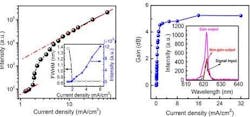Electrically pumped organic laser diode has low threshold current density
| Threshold and light amplification behavior in organic semiconductor lasers developed at Changchun Institute of Optics. (Image © Science China Press) |
Semiconductor lasers with organic molecular structures can produce color covering the entire visible spectrum and can potentially be easily mass-produced via solution processing. Organic lasers are small-sized, flexible, tunable, and easily integrated into devices for potential application in integrated photonics, visible light communication, sensors, and medical and scientific research. However, traditionally, organic semiconductor lasers have been optically rather than electrically pumped. Due to large optical losses from the device structure and a complex excited-state process, electrical pumping (electrical injection) of an organic laser diode conventionally requires an ultrahigh threshold current to achieve net gain, as most organic materials have poor electrical conductivity.
Now, Xingyuan Liu's research team at Changchun Institute of Optics, Fine Mechanics and Physics, Chinese Academy of Sciences (Changchun, China), has developed an organic quasi-continuous-wave (QCW) laser diode with a low threshold current density.1 Based on cavity quantum electrodynamics, the team determined that a planar half-wave microcavity of wavelength size can effectively control spontaneous emission and stimulated emission characteristics of organic semiconductors. The researchers overcame the problem of high cavity loss and designed and fabricated a high quality factor (Q) microcavity organic laser device, clearly observing gain amplification phenomenon under quasi-CW operation.
The organic laser uses a small-molecule doping system (Alq:DCJTI) as the gain medium; the laser peak wavelength is 621.7 nm and does not change with current increase. The threshold current density is about 1.8 mA/cm2, above which the spectral linewidth is narrowed to 0.835 nm. The organic semiconductor optical amplifier shows a maximum optical gain of 5.25 dB under 16 mA/cm2 electrical pumping. Obtaining a low laser threshold is an important step for the practical application of organic lasers, which will bring a room-temperature CW lasing in the near future. This indicated to the researchers that optical loss in the high-Q organic semiconductor microcavity was significantly reduced and that the underlying physics deserves further investigation.
REFERENCE:
1. Jie Lin et al., Science Bulletin (2017); https://doi.org/10.1016/j.scib.2017.12.010.
